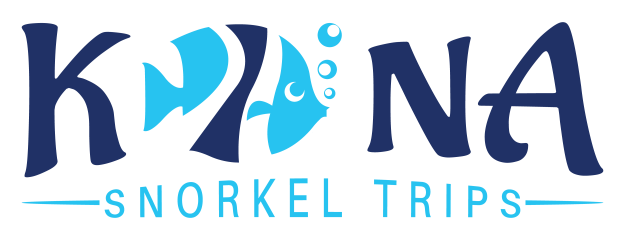Your Guide to Whale Watching Tours Kona Hawaii
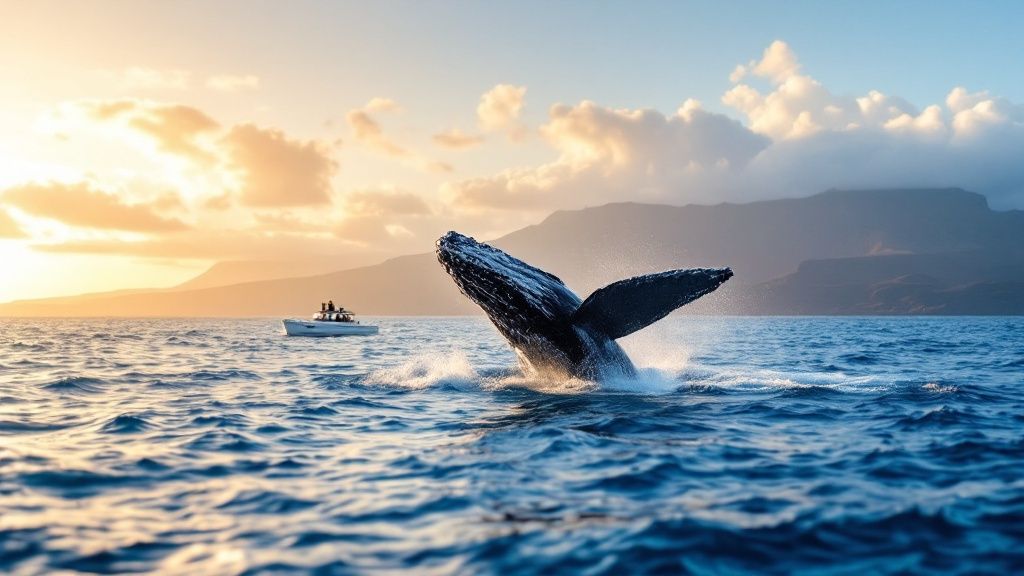
Picture this: the brilliant turquoise water off the Kona coast suddenly explodes. A forty-ton humpback whale launches itself into the air, hanging for a breathtaking moment against the backdrop of the volcanic shoreline before crashing back into the sea with a massive splash. This isn't some once-in-a-lifetime fluke; it's the heart and soul of the experience on whale watching tours in Kona, Hawaii.
If you're dreaming of seeing these gentle giants for yourself, you've come to the right place. This guide is your complete playbook for planning an adventure you'll never forget.
Your Essential Guide to Kona Whale Watching
Welcome! We're here to walk you through one of nature's most incredible shows. We'll get into why Kona's calm, protected waters are the preferred nursery for these majestic animals, making it a truly world-class destination to see them. You’ll learn exactly when to come, how to pick the perfect tour for your family or friends, and what amazing whale behaviors you should be looking for.
Right out of the gate, we want you to know you're in good hands. The experience you have depends heavily on your guide, which is why we'll be sharing insights from top-rated operators like Kona Snorkel Trips, the top rated & most reviewed snorkel company in Hawaii.
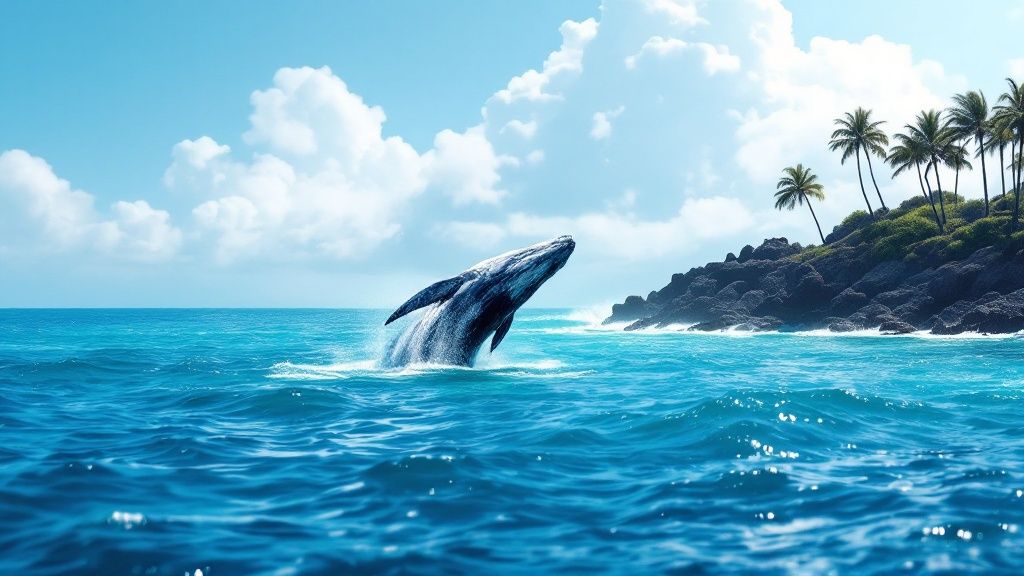
Why Kona Is a Premier Whale Watching Destination
The Big Island’s Kona coast is so much more than just another pretty Hawaiian shoreline; it's a sanctuary. Every winter, thousands of humpback whales make an epic journey, traveling over 3,000 miles from the frigid feeding grounds of Alaska to the warm, sheltered waters right here off Kona. So, why this specific spot?
It all comes down to the unique geography. The colossal volcanoes of Mauna Loa and Hualalai serve as natural windbreaks, shielding the leeward coast from the powerful trade winds. This creates exceptionally calm and clear seas—the perfect conditions for humpback whales to handle the most important business of their lives.
These peaceful waters are a safe haven where they can:
- Breed and give birth without having to battle rough seas or worry about many natural predators.
- Nurse their newborn calves, teaching them critical survival skills in a protected classroom.
- Rest and conserve energy after their long and demanding migration.
This incredible combination of safety and clarity makes the Kona coast one of the most reliable and awe-inspiring places on the planet to witness these marine mammals.
What Makes Humpback Whales So Special
Humpback whales, or kohola as they're known in Hawaiian, are famous for their mind-blowing behaviors and complex social lives. Unlike other whale species that might be a bit more camera-shy, humpbacks are the acrobats of the ocean, putting on thrilling displays that are as scientifically important as they are exciting to watch.
An adult humpback can stretch up to 60 feet long and weigh around 40 tons—that's roughly the size of a school bus. But don't let their size fool you; they are incredibly agile and can launch their entire bodies out of the water in a jaw-dropping breach.
These whales were once hunted to the verge of extinction. Their incredible comeback, thanks to worldwide conservation efforts, makes every single sighting a powerful symbol of resilience. It's a living reminder of our duty to protect them.
Watching them isn't just a visual spectacle; it's an auditory one, too. Male humpbacks are famous for their complex and haunting songs, which can travel for miles through the water. Many whale watching tours in Kona, Hawaii, come equipped with hydrophones, letting you listen in on these underwater symphonies. It's a truly moving experience that connects you directly to their world, solidifying their status as the undisputed superstars of the sea.
Navigating the Kona Whale Watching Season
Timing is everything when it comes to whale watching in Kona. It’s not just about booking a boat; it’s about plugging into one of the most incredible migrations on the planet—a massive annual journey that turns Kona’s calm, blue waters into a bustling nursery for humpback whales. Understanding this rhythm is the secret to planning a trip you’ll be talking about for years.
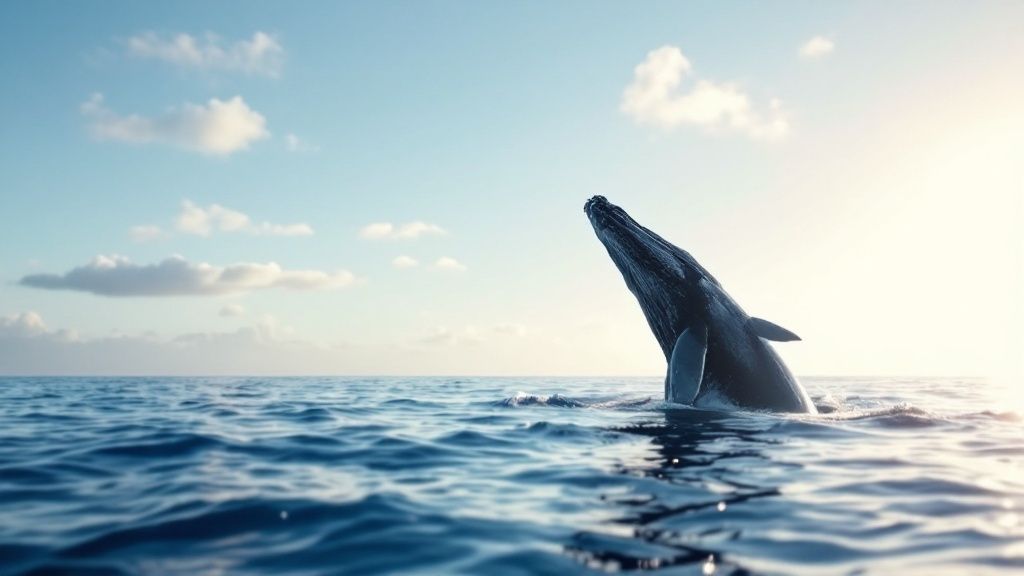
This whole incredible story starts way up north in the cold, food-rich waters of Alaska. After a summer of feasting and fattening up, the humpbacks begin a grueling 3,000-mile trek south. Their destination? The warm, protected seas right here off the Kona coast—the perfect sanctuary to give birth and raise their newborn calves, safe from predators and rough seas.
Kona Whale Watching Season At-a-Glance
To give you a clearer picture, here's a simple breakdown of what the season looks like month by month. While the peak is definitely the sweet spot, you can see how the action ramps up and then winds down.
| Month | Whale Activity Level | Typical Sightings and Behaviors |
|---|---|---|
| November | Low | The first few scouts arrive. Sightings are sporadic. |
| December | Moderate to High | Numbers rapidly increase. Good chance to see adults. |
| January | Peak | Waters are bustling. Breaches and tail slaps are common. |
| February | Peak | Highest concentration of whales. Prime time for seeing calves. |
| March | High | Still plenty of action, but whales begin their journey north. |
| April | Moderate to Low | Most whales have left; you might catch a few stragglers. |
| May | Very Low | The last few whales depart. The season is effectively over. |
As you can see, if you're aiming for that awe-inspiring, whale-filled experience, timing your trip for the heart of the season makes all the difference.
The Peak Season for Whale Sightings
While a few early birds might show up in November and some linger into May, the prime time for whale watching is crystal clear. The absolute peak season slams into gear from mid-December through March. This is when the humpback population in Hawaiian waters is at its absolute highest.
During these months, the ocean is just electric with activity. It stops being a question of if you'll see whales and becomes a question of how many and what they'll be doing. This is your best shot to witness those iconic behaviors that make humpbacks famous—powerful breaches, thundering tail slaps, and those quiet, tender moments between a mother and her calf.
The Kona and Kohala Coasts are world-renowned hotspots for this very reason. Some data even shows the Kohala Coast can have two to three times more whale activity than other parts of the island, especially in January and February. It’s not uncommon to average 3 to 6 whales every 15 minutes, and on a really good day, some lucky boats have reported seeing as many as 15 to 20 whales at once.
Why Morning Tours Are Often Recommended
When you start looking at tours, you'll see most companies offer both morning and afternoon trips. Honestly, any time on the water during peak season is a win, but there’s a solid reason morning tours are so popular with seasoned guides and locals.
The Kona coast is famous for its calm morning seas. The ocean is often glassy and still before the afternoon winds pick up, creating ideal conditions for spotting whale spouts and surface behaviors from a distance.
These calm conditions do more than just make for a smoother ride (though your stomach will thank you). The lack of choppy water makes it so much easier to see the whales clearly. Plus, that dramatic, low-angled morning light can create some truly breathtaking photo ops.
If you really want to dig into the details of this incredible migration, check out our complete guide to the whale season on the Big Island.
Bottom line: aiming for the peak months and leaning toward a morning tour will seriously stack the odds in your favor for having that jaw-dropping encounter that puts Kona whale watching on so many bucket lists.
Choosing Your Ideal Whale Watching Tour
Not all whale watching tours in Kona, Hawaii, are the same. Far from it. The boat you end up on can completely change the vibe of your day, making the difference between a chill, laid-back family cruise and a heart-pounding, up-close adventure. It really comes down to matching the boat to your own personal style and what you want to get out of the experience.
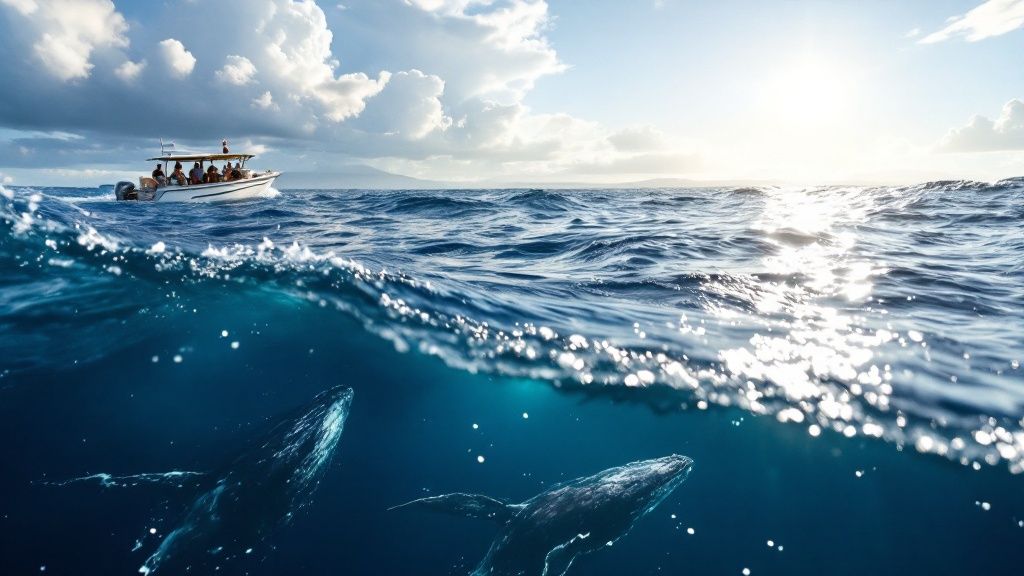
Think of it like going on a safari. You could opt for the big, comfortable tour bus with high windows for a great overview, or you could jump in a rugged, open-air jeep to get right down in the thick of it. In Kona, your main options are large catamarans and the smaller, zippier zodiac-style rafts. Each one gives you a totally unique way to see the incredible humpback whales.
Large Catamarans: The Floating Observation Decks
If comfort and stability are at the top of your list, a spacious catamaran is probably your best bet. These are the tour buses of the sea, perfect for families, big groups, or anyone who just wants a smooth, relaxing ride. They're built for comfort.
The biggest plus is their size. You’ve got room to roam around, multiple decks to choose from, and usually some shaded spots to get out of the sun. This freedom of movement means you can always find the best spot to watch the action or just soak in the views of the Kona coast. And because they're so stable, they're a lifesaver for anyone who gets a little queasy on the water.
Here’s the rundown on what to expect on a catamaran:
- More Amenities: Onboard bathrooms, snacks, and shaded seating are pretty standard. It makes for a very comfortable few hours on the ocean.
- Higher Vantage Point: Being higher off the water gives you a fantastic panoramic view, making it easier to spot those distant whale spouts.
- Larger Group Sizes: These boats can carry more people, which creates a fun, social atmosphere as everyone shares in the excitement.
- Stability: Their dual-hull design cuts through the water smoothly, seriously minimizing that rocking and rolling motion.
The trade-off is that the experience feels a little less intimate with a bigger crowd, but for a family-friendly, comfortable day of whale watching, you really can’t go wrong.
Zodiac Rafts: The Sea-Level Adventure
For those with a bit more of an adventurous spirit, a zodiac-style raft is a whole different ball game. These are the jeeps of the ocean—small, fast, and built to get you right down on the water.
Picture yourself at eye-level with a humpback as it breaks the surface just a stone's throw away. That’s the kind of raw, thrilling moment a zodiac can deliver. Their speed and agility mean captains can get you to the action fast and position the boat for some truly epic photo ops.
There's something powerful about being so low to the water. You get a true sense of scale and connection when you're looking up at a 40-ton whale. It really puts their immense size into perspective.
Of course, this kind of adventure means sacrificing some creature comforts. The ride is bumpier, and you should definitely expect to get splashed. For that reason, it’s probably not the best choice for very young kids or anyone with back problems or mobility issues.
Key Factors To Consider
So, how do you choose? When you're looking at a whale watching tour in Kona, Hawaii, just think about what's most important to you. Is it about lounging in comfort, or is it about feeling the spray on your face as you zip across the water?
Mull over these points:
- Group Size: Do you enjoy the buzz of a larger group, or would you prefer a more personal trip with just a few other people?
- Comfort Level: Are things like a bathroom and shade must-haves? Or are you willing to trade them for a more rugged, wild ride?
- Thrill Factor: Are you hoping for a calm cruise or an adrenaline rush?
- Photography: The steady deck of a catamaran is great for crisp, stable shots. A zodiac, on the other hand, can get you those dramatic, low-angle photos if you can manage the movement.
At the end of the day, there’s no right or wrong answer—just what's right for you. Weigh your options, and you’ll book the tour that gives you the perfect whale watching memory you came here for.
Witnessing a World of Marine Life
While the magnificent humpback whales are the stars of the show on any whale watching tour in Kona, Hawaii, they’re definitely not the only performers out here. Think of it as a front-row seat to a massive, vibrant marine theater. The waters off the Kona coast are teeming with life, and your tour is a chance to see how this dynamic ecosystem works. Knowing who the other players are transforms your trip from just a whale hunt into a full-blown marine safari you won't forget.
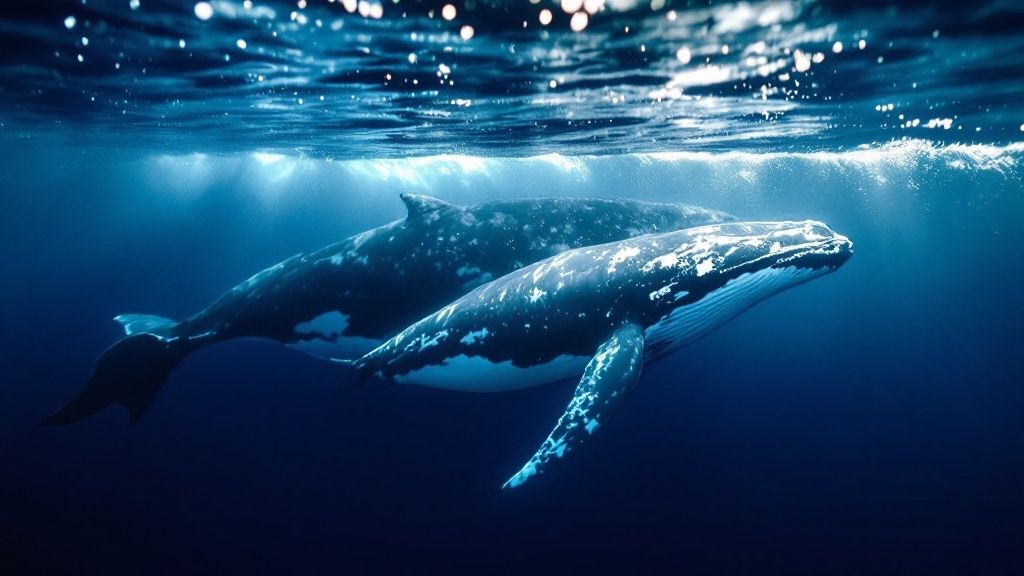
Decoding Whale Behavior
When you see a humpback, you’re not just looking at a giant animal—you're witnessing a complex language being spoken right on the surface. Every splash, every movement has a purpose. Once you start to understand what these actions mean, you'll gain a whole new level of appreciation for what you're seeing.
Keep an eye out for these incredible behaviors:
- The Breach: This is the iconic, show-stopping moment. A whale launches its entire 40-ton body out of the water in a spectacular display. Scientists figure it could be a way to communicate over long distances, shake off pesky parasites, or maybe, just maybe, an expression of pure joy.
- The Tail Slap (Lobtailing): You’ll hear this one before you see it. A whale smacks its massive tail fluke on the water, creating a thunderous crack that travels for miles underwater. It’s often used to communicate with other whales or to show a bit of aggression.
- The Spyhop: This is one of my favorites. A whale pops its head straight up out of the water, almost like a periscope, to get a good look around. It feels like they're just as curious about us as we are about them.
- The Pec Slap: Humpbacks have the longest pectoral fins (their "arms") of any whale, and they love to show them off. They'll often roll onto their side and slap a fin against the water, another loud form of communication that really gets your attention.
It's like listening to a language spoken without words. A breach might be a shout of excitement, while a spyhop is more like a curious whisper. Each action gives you a fleeting glimpse into the secret lives of these incredible creatures.
The Supporting Cast of Kona Marine Life
The adventure doesn't stop with the humpbacks. Kona’s waters are a bustling metropolis for a whole crew of marine animals that often pop in to say hello, adding some wonderful surprises to your tour.
You’ll want to keep your eyes peeled for the locals. Playful pods of spinner dolphins are a common sight, famous for launching themselves into the air in dazzling spins as they ride the boat's wake. You might also spot larger pilot whales traveling in tight-knit family groups or even sleek, powerful false killer whales.
These unexpected encounters really highlight the incredible biodiversity that makes Kona so special. It's not just humpbacks; on any given day, you could see bottlenose dolphins, Hawaiian monk seals, and even the occasional oceanic whitetip shark or whale shark. Kona is a true hotspot for marine wildlife.
A World Beneath the Waves
While you’re focused on all the action at the surface, don’t forget that an entire world is thriving just below your boat. The crystal-clear waters here give you a stunning window into the vibrant coral reef ecosystem.
It's not uncommon to spot a green sea turtle (honu) gliding gracefully by or even a massive manta ray cruising near the surface. The colorful reef fish themselves are a spectacle, and learning a bit about them enriches your whole experience. To get to know the locals a little better, check out our comprehensive Hawaii reef fish guide.
This knowledge turns every glance into the water into an opportunity for discovery, connecting the giants of the deep with the smaller, equally fascinating creatures that share their home.
How to Prepare for Your Whale Watching Adventure
A little prep work goes a long, long way in making sure your whale watching tour in Kona, Hawaii, is an unforgettable experience. If you think ahead just a bit, you can make sure you’re comfortable, safe, and ready to soak in every incredible moment without a single distraction. Let's walk through everything from what to wear to what you should ask before you even book.
What to Pack for Your Day on the Water
Getting your gear right is the first step to a perfect day out there. The tour boat will have the basics covered, but a few personal items of your own will make a world of difference for your comfort. Just think of it as packing for a few hours in an ever-changing environment—sun, wind, and sea spray are all part of the fun.
Here's what should be in your bag:
- Polarized Sunglasses: Regular sunglasses are fine, but polarized lenses are a total game-changer. They slice right through the harsh glare on the water, making it so much easier to spot a whale spout or a dolphin fin.
- Reef-Safe Sunscreen: That Hawaiian sun is no joke. Be sure to grab a mineral-based, reef-safe sunscreen (look for zinc oxide or titanium dioxide) to protect your skin and the fragile coral reefs below.
- A Light Jacket or Windbreaker: Even on a beautiful, warm day, the breeze coming off the open ocean can have a surprising chill to it, especially on those early morning tours. A light layer is all you'll need to stay cozy.
- Camera or Smartphone: You’re going to want to capture these memories! Just make sure your device has a full battery. You might also want to consider a waterproof case or at least a wrist strap for a little extra security.
Preventing Seasickness Before It Starts
Absolutely nothing ruins an amazing whale encounter faster than a bout of seasickness. Kona’s waters are famously calm, but it's always smart to be prepared, especially if you know you're prone to motion sickness.
The real key here is to be proactive, not reactive. Simple things you do before even stepping on the boat can make all the difference. For instance, staying hydrated and skipping heavy, greasy foods beforehand can really help settle your stomach. Over-the-counter options like Dramamine or Bonine work well for a lot of people, but you usually need to take them an hour before you head out. For a deeper dive into all your options, we've put together more proven strategies in our guide on how to prevent seasickness.
A classic mistake is waiting until you start feeling queasy to do something. Prevention is your best friend. Once you're on the water, simply focusing on the horizon and getting plenty of fresh air can also work wonders.
Your Whale Watching Tour Checklist
To make things even easier, here's a quick checklist to run through. It covers the essentials to bring, what to do before you go, and some key questions to ask. A little planning now means you can just relax and enjoy the show later.
| Essential Items to Pack | Pre-Tour Preparation Tips | Questions for Your Tour Operator |
|---|---|---|
| ✓ Polarized Sunglasses | ✓ Check the weather forecast | ✓ What's your sighting success rate? |
| ✓ Reef-Safe Sunscreen | ✓ Eat a light meal beforehand | ✓ What's your policy if we don't see whales? |
| ✓ Light Jacket or Windbreaker | ✓ Stay hydrated (water is best!) | ✓ How do you follow whale viewing guidelines? |
| ✓ Fully-Charged Camera/Phone | ✓ Take seasickness meds early | ✓ What amenities are on board? (restrooms, shade) |
| ✓ Hat and/or Sun Shirt | ✓ Get a good night's sleep | ✓ Are snacks and drinks included? |
| ✓ Reusable Water Bottle | ✓ Arrive at the dock on time | ✓ Is there an in-water guide or naturalist? |
Taking a few minutes to tick these boxes will ensure you're fully prepared for an incredible day.
Essential Questions for Your Tour Operator
Before you click that "book now" button, it's worth taking a moment to ask your potential tour operator a few important questions. Their answers will tell you a lot about the kind of experience they provide and how seriously they take their responsibility to the whales. If you're bringing the whole family, you might also find some helpful tips for traveling with young children to make sure the trip is smooth for everyone.
Think about asking these:
- What is your sighting success rate during peak season? Nobody can guarantee wildlife sightings, of course, but an experienced crew should have a very high success rate (often 95% or better). They should also have a clear policy for what happens on the rare chance you don't see any whales.
- How do you adhere to federal and state viewing guidelines? A truly responsible operator is passionate about protecting these animals. They'll be happy to tell you exactly how they maintain the required 100-yard distance and follow all the other best practices.
- What amenities are included on the tour? It’s always good to clarify if things like snacks, drinks, or sunscreen are provided. Also, confirm there’s a restroom on board and shaded areas, which can be really important for comfort.
This little bit of homework ensures you pick a tour that's a perfect fit, leaving you free to just sit back and enjoy the pure magic of Kona’s whales.
A Guide to Responsible Whale Watching
Seeing a forty-ton humpback whale launch itself out of the water is a memory that sticks with you forever. But with that incredible privilege comes a serious responsibility. The thrill of a whale watching tour in Kona, Hawaii, is matched by our duty to protect these gentle giants. The most important choice you'll make isn't which boat to pick, but which ethic you want to support.
It all boils down to a simple idea: we're guests in their home. The calm, warm waters off the Kona coast are much more than a pretty backdrop. This is a sanctuary—a critical nursery where humpback whales travel thousands of miles to give birth, nurse their calves, and mate. Any disturbance here can cause incredible stress, potentially separating a mother from her baby or disrupting behavior essential for their survival.
The Golden Rule of Whale Watching
To keep the whales safe and stress-free, both federal and state laws lay down some very clear ground rules for all boats on the water. The big one? Distance.
By law, every boat has to stay at least 100 yards away from humpback whales in Hawaiian waters. Think of it as a football field-sized buffer zone, giving the whales the space they need to go about their business without feeling crowded or threatened.
This isn't just a friendly suggestion; it's the law, and any good tour operator treats it with the utmost respect. A truly ethical captain will never chase down or corner a whale. Instead, you'll see them expertly position the boat parallel to a whale's path, often cutting the engines entirely. This lets the curious giants decide if they want to approach, putting the encounter entirely on their terms.
How to Spot a Genuinely Responsible Tour
So, how can you tell the good operators from the ones just trying to make a quick buck? Look for the companies that do more than just follow the rules—they live and breathe conservation.
- They're Also Teachers: The best guides are total nature nerds, and they can't wait to share their passion. They'll tell you all about whale behaviors, the challenges they face, and why protecting them matters, turning your trip into a mini-marine biology class.
- They Lead by Example: A responsible crew is proud of their high standards. They'll openly talk about their viewing protocols and their commitment to the whales' well-being because they see themselves as guardians of the ocean.
- They're Part of the Science: Many of Kona's best tour companies work hand-in-hand with marine researchers. They contribute priceless data from their daily trips—logging sightings, behaviors, and fluke IDs—that helps scientists understand and protect these amazing animals for the long haul.
When you choose a tour like this, your ticket does more than just get you on a boat. You're directly funding a community of businesses that are all-in on preserving Hawaii's marine world.
The proof is in the numbers. The fact that so many whales make the journey back to Hawaii each year shows that these protections are working. In the 2025 season alone, a single day's count tallied nearly 2,121 whale sightings across the islands, and the Big Island was a hotspot with 493 of them. You can learn more about this incredible citizen science effort from Big Island Now. These numbers aren't just statistics; they're a powerful reminder of what we're all working to protect. By choosing your tour wisely, you become a partner in making sure the magic of Kona's whales is here for generations to come.
Kona Whale Watching Frequently Asked Questions
Planning a whale watching tour in Kona, Hawaii is exciting, but you probably have a few last-minute questions floating around. To make sure you feel totally ready for your adventure, we've put together answers to the queries we hear most often. Think of this as your final checklist before you head out on the water.
Is There a Guarantee I Will See Whales?
This is the big one, right? While nobody can ever 100% guarantee a wildlife sighting, the chances during Kona's peak season (mid-December through March) are incredibly high. Most of the top-notch crews around here report spotting whales on well over 95% of their trips during that window.
For extra peace of mind, a lot of companies offer a "whale guarantee." It's not a money-back thing, but it usually means if you don't see any whales, you can come back another day for free. It’s always a smart move to ask about the specifics when you book your tour.
Are Whale Watching Tours Safe for Children?
Absolutely! Whale watching is one of those rare activities that genuinely mesmerizes the whole family. Seeing a 40-ton animal launch itself out of the water is a core memory in the making for kids and adults.
If you have little ones or toddlers, I'd steer you towards the larger, more stable boats like catamarans. They’ve got more room to roam, plenty of shade, and, crucially, bathrooms on board. Some of the smaller, speedier boats like zodiacs might have age or height limits, so it's best to double-check with the company if you're bringing younger kids along.
What Is the Best Camera for Whale Watching?
To get those jaw-dropping, "I can't believe I saw that" photos, a camera with a good zoom or telephoto lens is your best friend. It lets you get crisp, detailed shots from the required 100-yard respectful distance.
A fast shutter speed is also a huge plus, especially for freezing the action of a powerful breach. But hey, don't sweat it if you're not a pro photographer. Modern smartphones have seriously impressive cameras and can capture amazing photos and videos you'll be thrilled to share.
What Happens if a Tour Is Canceled Due to Weather?
Safety always, always comes first. Every captain in Kona keeps a close eye on the ocean conditions. If things look dicey—think high winds or big swells—they will cancel the tour for safety. It's not a call they make lightly.
When this happens, you’ll typically have two choices: reschedule for another day or get a full refund. Just make sure you're clear on the company's specific weather policy before you lock in your booking.
Ready to witness the magic of Kona's humpback whales? Kona Snorkel Trips offers unforgettable, small-group tours led by expert guides, ensuring you have the best and safest experience on the water.
